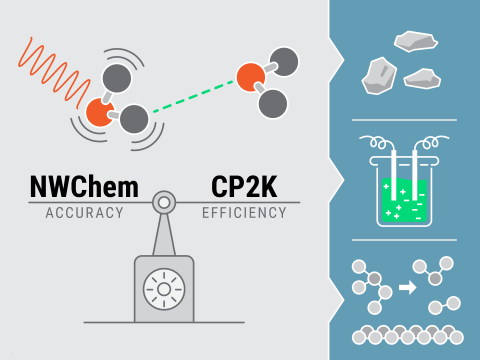A recent special issue in The Journal of Chemical Physics highlights Pacific Northwest National Laboratory's (PNNL) contributions to developing two prominent open-source software packages for computational chemistry used by scientists around the world.
PNNL researchers have been instrumental in developing the software packages, called NWChem and CP2K. These programs offer complementary approaches to calculating electronic structure, which is fundamental to atomic behavior and chemical bonding.
According to the abstract for this special issue, "the electronic structure community now has a wonderfully diverse arsenal of software packages available for performing calculations on molecules and materials." NWChem and CP2K are included in that arsenal.
For decades, computational chemists have been working to develop ways to effectively solve equations that describe how electrons move around atoms, how atoms connect to make molecules, and how electrons respond to stimuli. Solving these equations often requires complex calculations that consume computing time and processing resources. Computational chemists carefully develop and optimize electronic structure algorithms to balance computational efficiency with predictions accurate enough to recreate observations in actual molecular and materials systems in realistic environments.
"Now the theory, computational techniques, and processor hardware are all at a point where researchers can use these packages regularly," said Greg Schenter, a physicist and Laboratory Fellow at PNNL.
Researchers around the world use atomistic computer simulations to explain new scientific phenomena, interpret experimental measurements, predict materials properties and the products of chemical reactions, and design new molecular systems. NWChem and CP2K provide information that allows scientists to efficiently tune, control, and design molecular processes for desired outcomes.
Researchers at PNNL use the results from these packages in their own work. They help chemists create more efficient catalysts; biologists study proteins that transform biomass into fuel; battery researchers study ion transfer in electrolytes; and geochemists and environmental scientists uncover molecular mechanisms in biogeochemical transformations.

NWChem: accurate ground and excited-state properties of molecules and materials
NWChem, also known as NorthWest Chemistry, was first developed in the 1990s at the Environmental Molecular Sciences Laboratory, a U.S. Department of Energy, Office of Science user facility at PNNL. It was developed to harness the power of massively parallel supercomputers.
The code has evolved to run on computing facilities and personal computers. NWChem is now widely used at universities, other national laboratories, and computer centers around the world.
NWChem models the ground and excited-state electronic structure and dynamics of molecules and condensed-phase systems at different levels of accuracy and detail. The precision and detail of the predictions produced by NWChem allow researchers to predict properties and experimental spectroscopic signals over a broad range of systems, including molecules, nanostructures, solids, and biomolecules.
CP2K: efficient calculations for molecular ensembles
CP2K had its beginning in 2000, providing efficient models of electronic structure to simulate large chemical systems in the condensed phase to elucidate collective behavior. It performs atomistic simulations of solid-state, liquid, molecular, periodic, material, crystal, and biological systems.
Schenter describes CP2K as the pocket multi-tool of molecular simulations because it has a wide range of capabilities in an easy-to-use package.
The software incorporates statistical mechanics, which makes it useful to capture phenomena in the collective dance of molecular ensembles. Because of the calculational flexibility, CP2K is widely used in the computational chemistry community and designed with efficient algorithms that are necessary for the study of heterogeneous condensed phase systems. Users can also easily modify the software to suit their computational needs.
At PNNL, NWChem has received support from the Basic Energy Sciences, Biological and Environmental Research, and Advanced Scientific Computing Research programs, while CP2K developments have been funded by the Basic Energy Sciences program; all of these programs are in the U.S. Department of Energy, Office of Science.
Looking ahead, PNNL plans to continue building on its long history of advancing software tools like these for fundamental research.
"PNNL researchers have been involved with developing software tools for electronic structure calculation for decades, and the tools have advanced to efficiently describe complex phenomena. Now we are evolving the packages to work with increasingly realistic systems," Schenter said.






